Abstract
The magnitude (Zrs) and phase angle (thetars) of the total respiratory impedance (Zrs), from 3 to 45 Hz, were rapidly obtained by a modification of the forced oscillation method, in which a random noise pressure wave is imposed on the respiratory system at the mouth and compared to the induced random flow using Fourier and spectral analysis. No significant amplitude or phase errors were introduced by the instrumentation. 10 normals, 5 smokers, and 5 patients with chronic obstructive lung disease (COPD) were studied. Measurements of Zrs were corrected for the parallel shunt impedance of the mouth, which was independently measured during a Valsalva maneuver, and from which the mechanical properties of the mouth were derived. There were small differences in Zrs between normals and smokers but both behaved approximately like a second-order system with thetars = 0 degree in the range of 5--9 Hz, and thetars in the range of +40 degrees at 20 Hz and +60 degrees at 40 Hz. In COPD, thetars remained more negative (compared to normals and smokers) at all frequencies and crossed 0 between 15 and 29 Hz. Changes in Zrs, similar in those in COPD, were also observed at low lung volumes in normals. These changes, the effects of a bronchodilator in COPD, and deviations of Zrs from second-order behavior in normals, can best be explained by a two-compartment parallel model, in which time-constant discrepancies between the lung parenchyma and compliant airway keep compliant greater than inertial reactance, resulting in a more negative phase angle as frequency is increased.
Full text
PDF
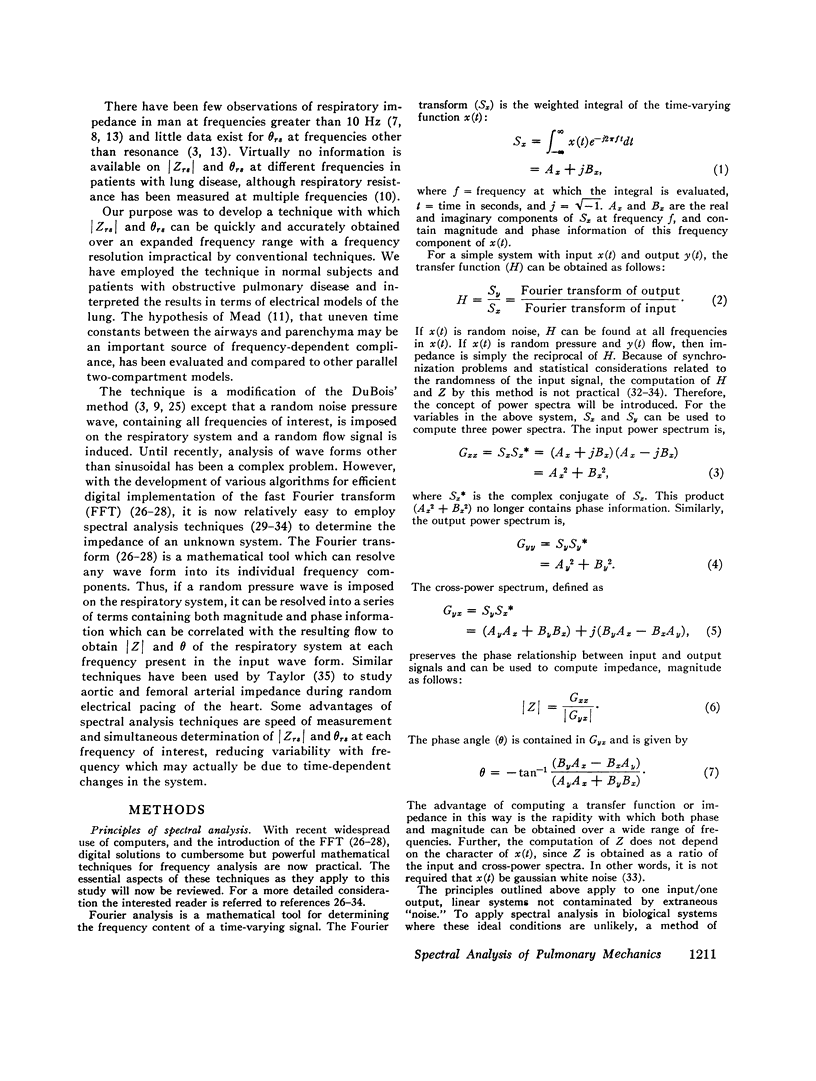
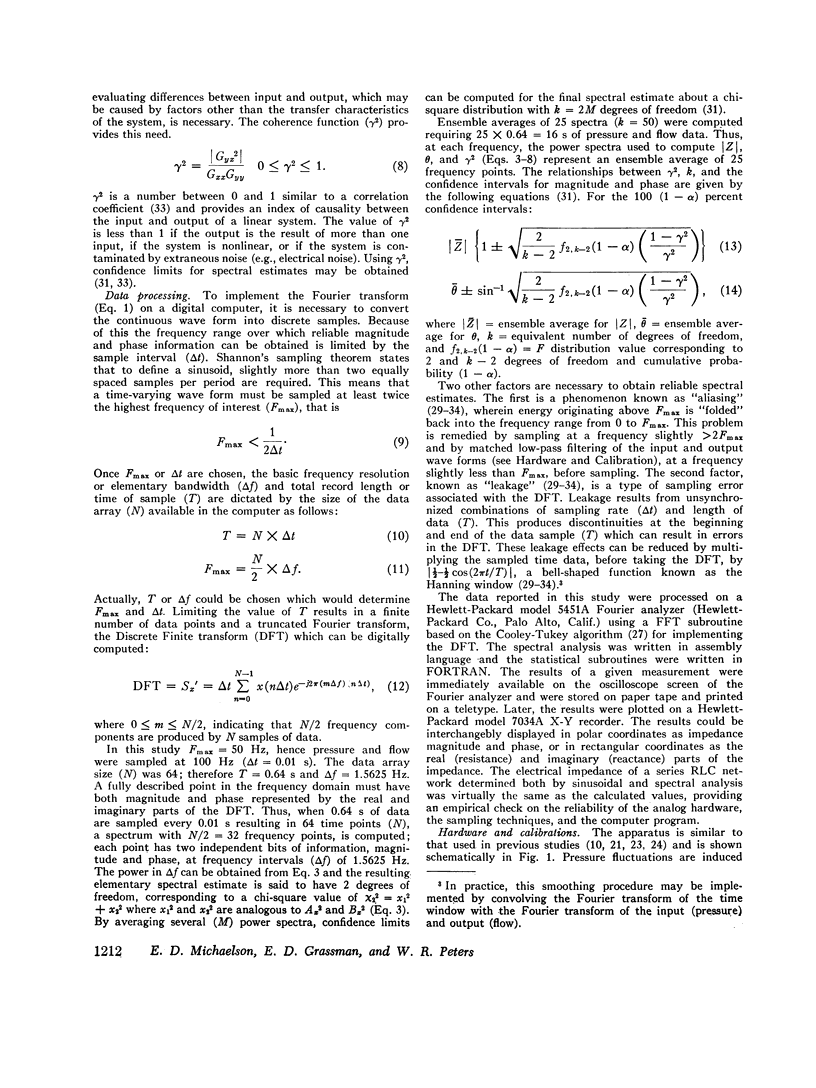
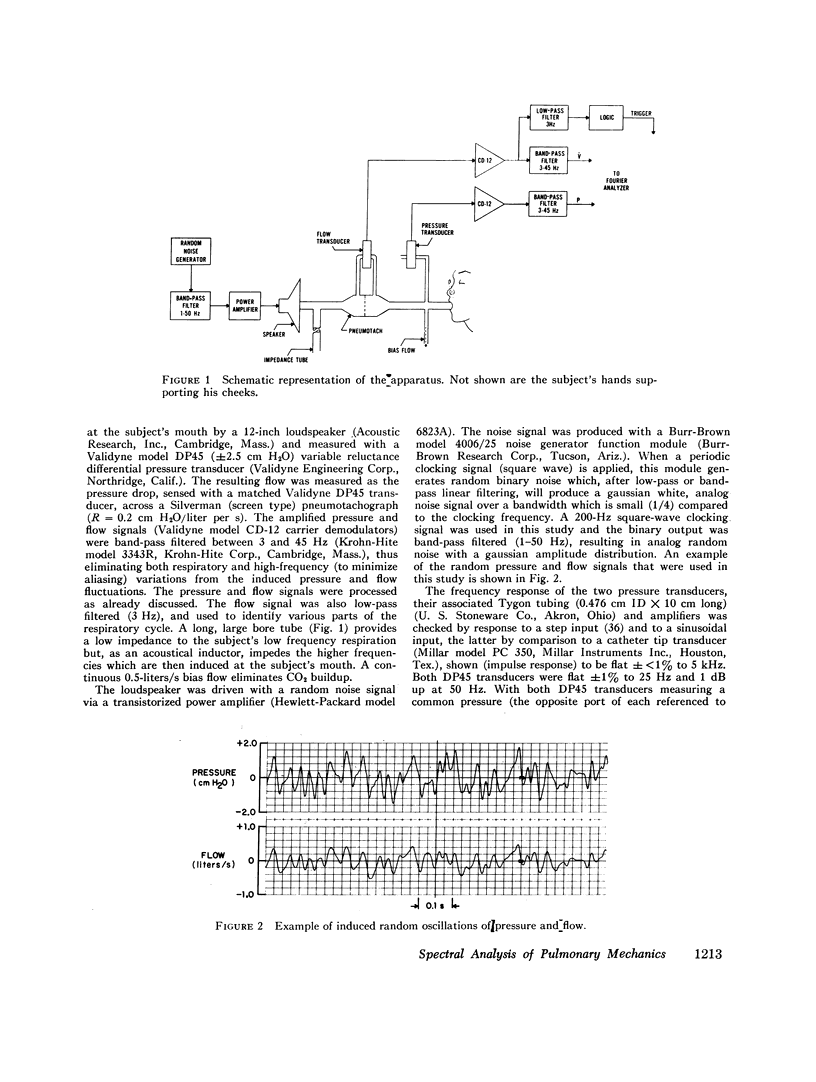
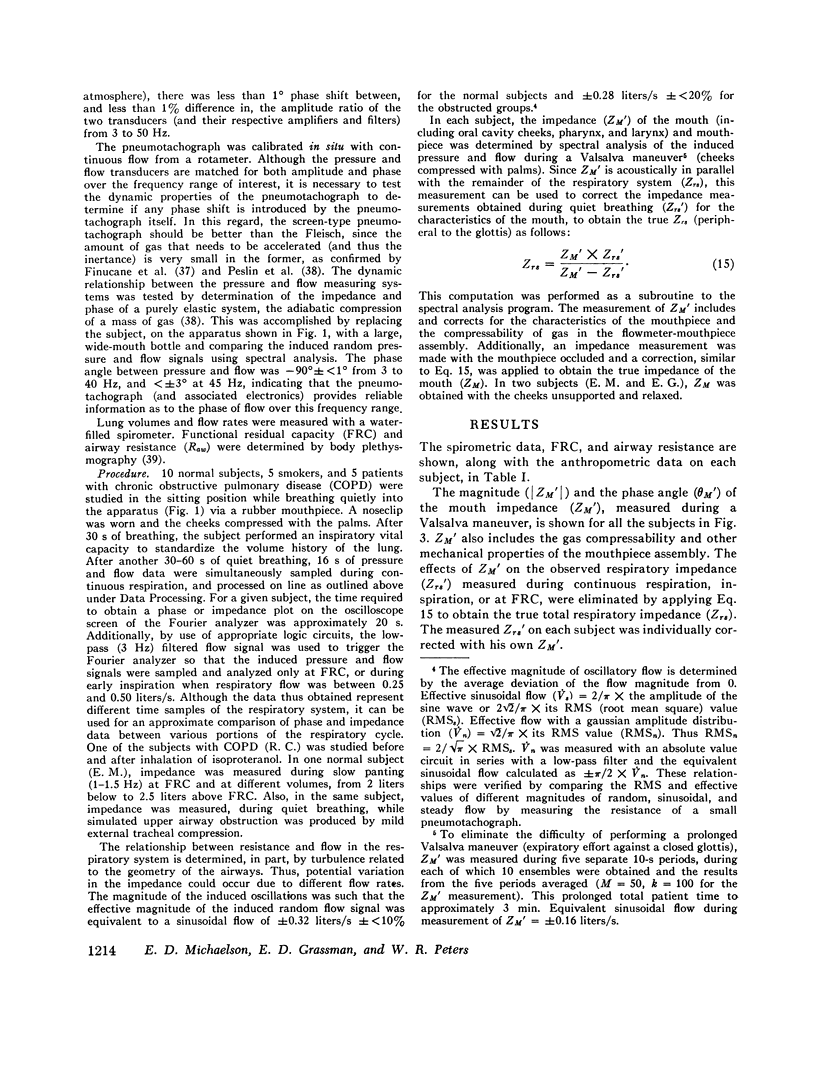
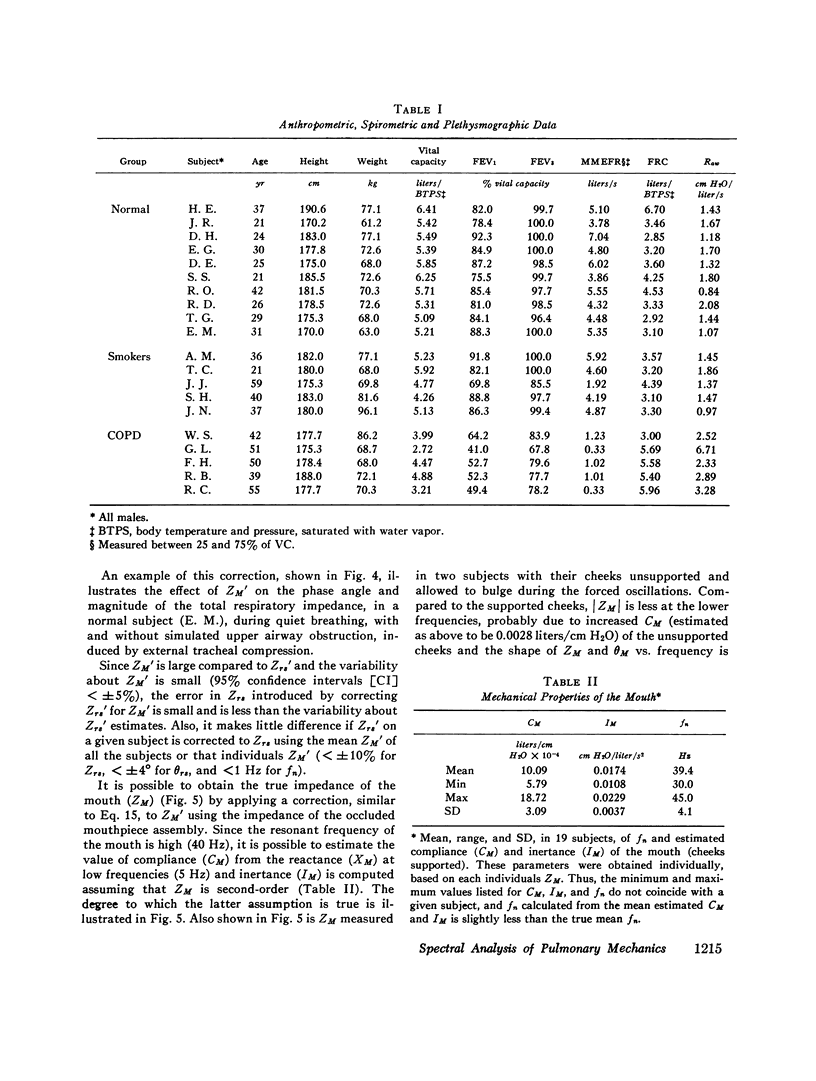


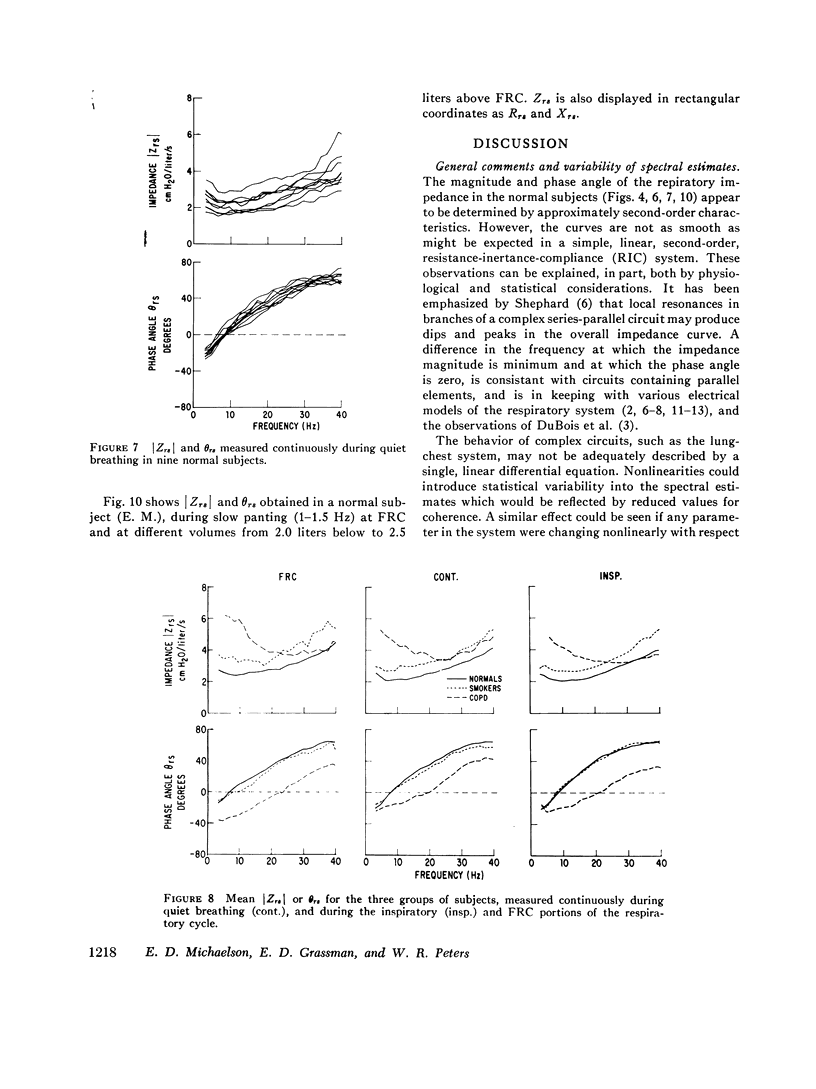
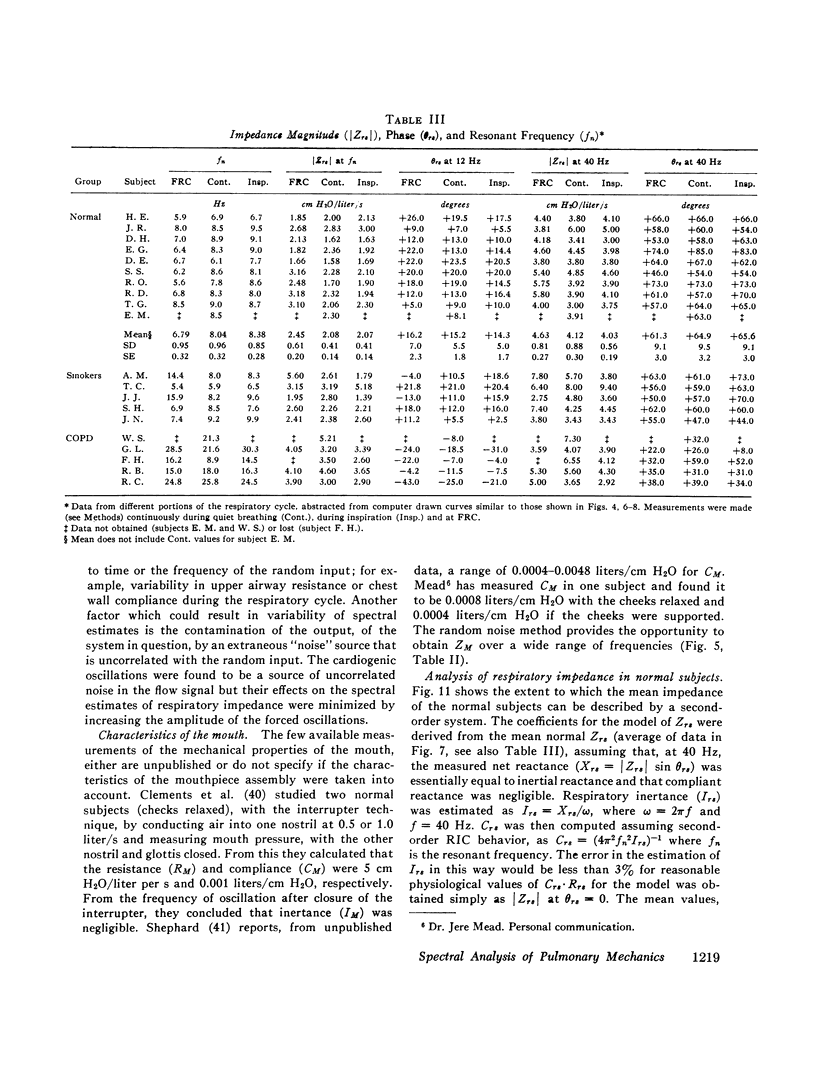
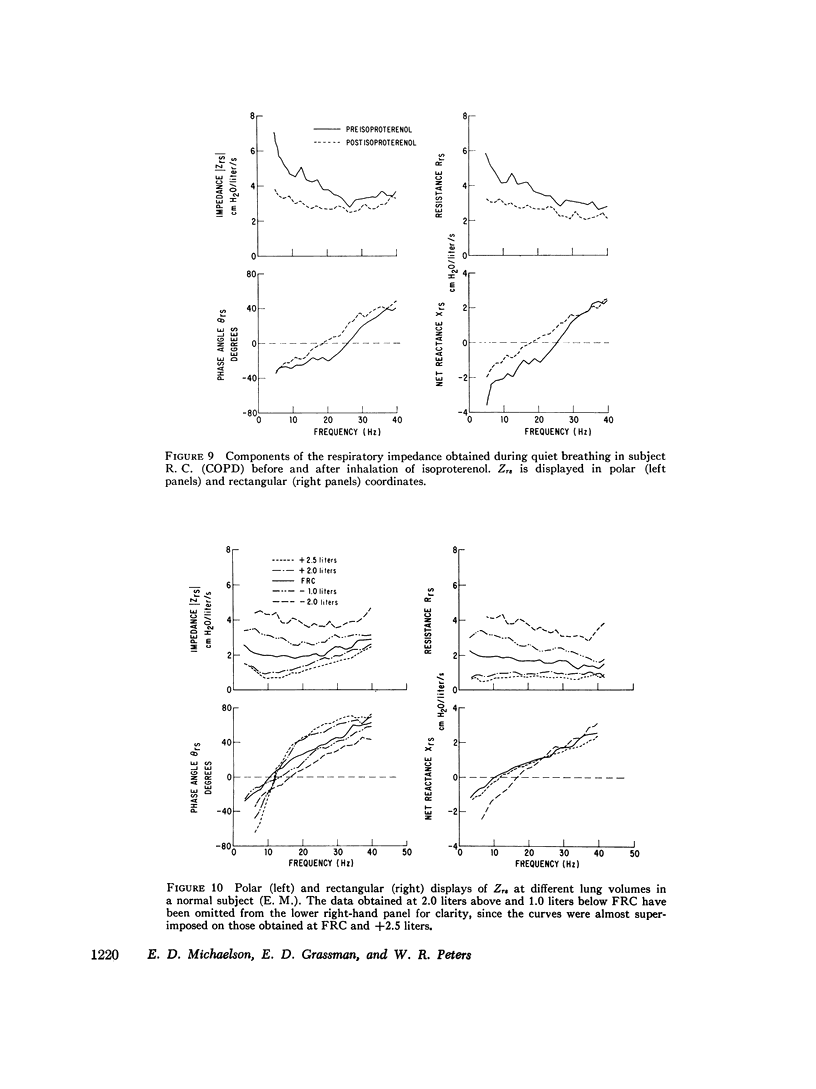
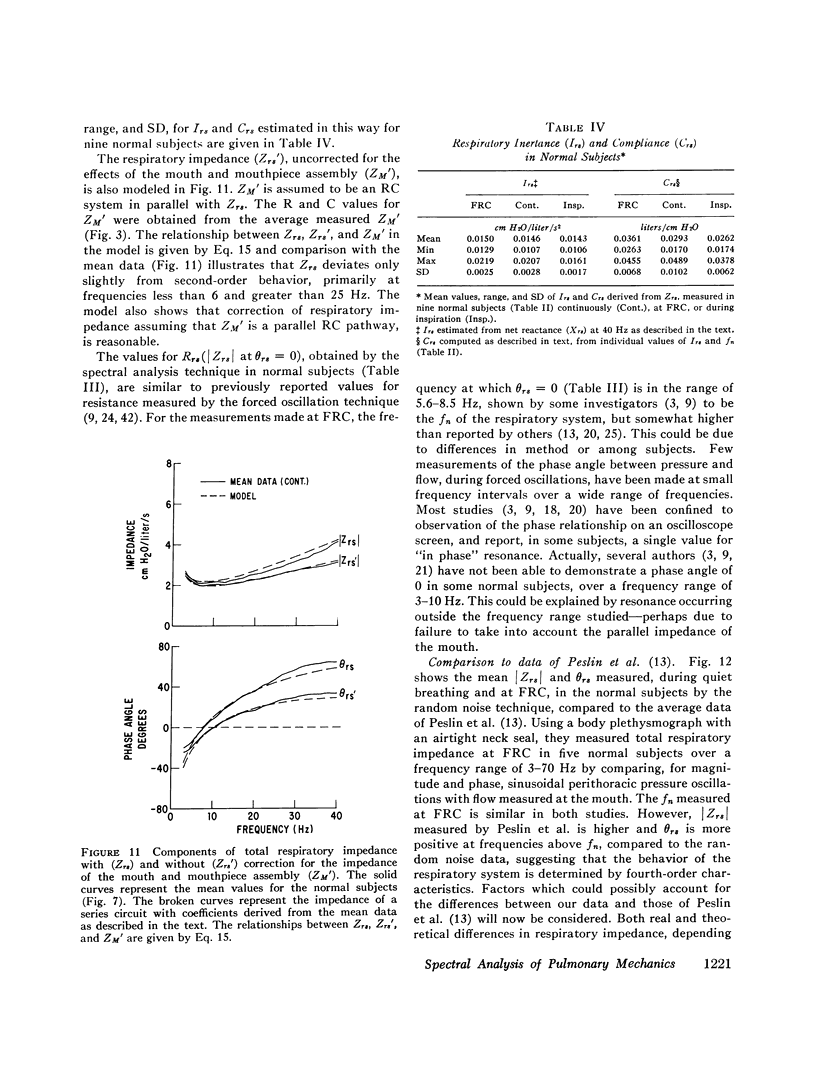
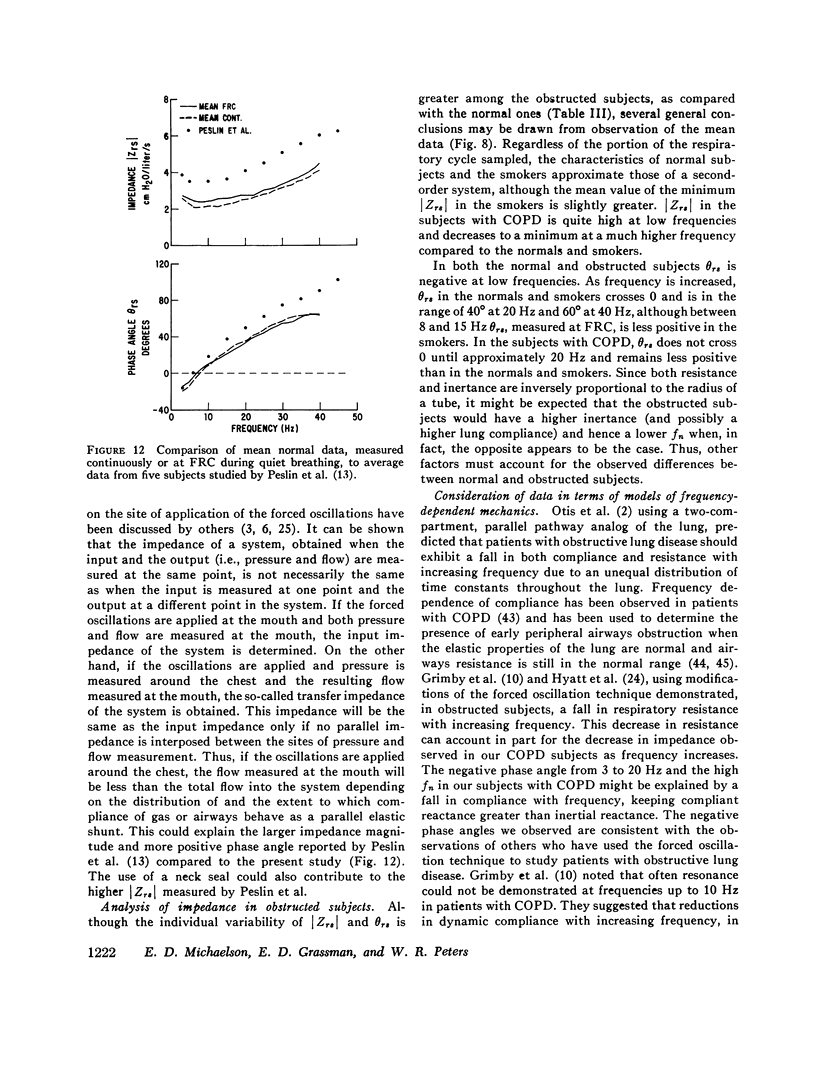
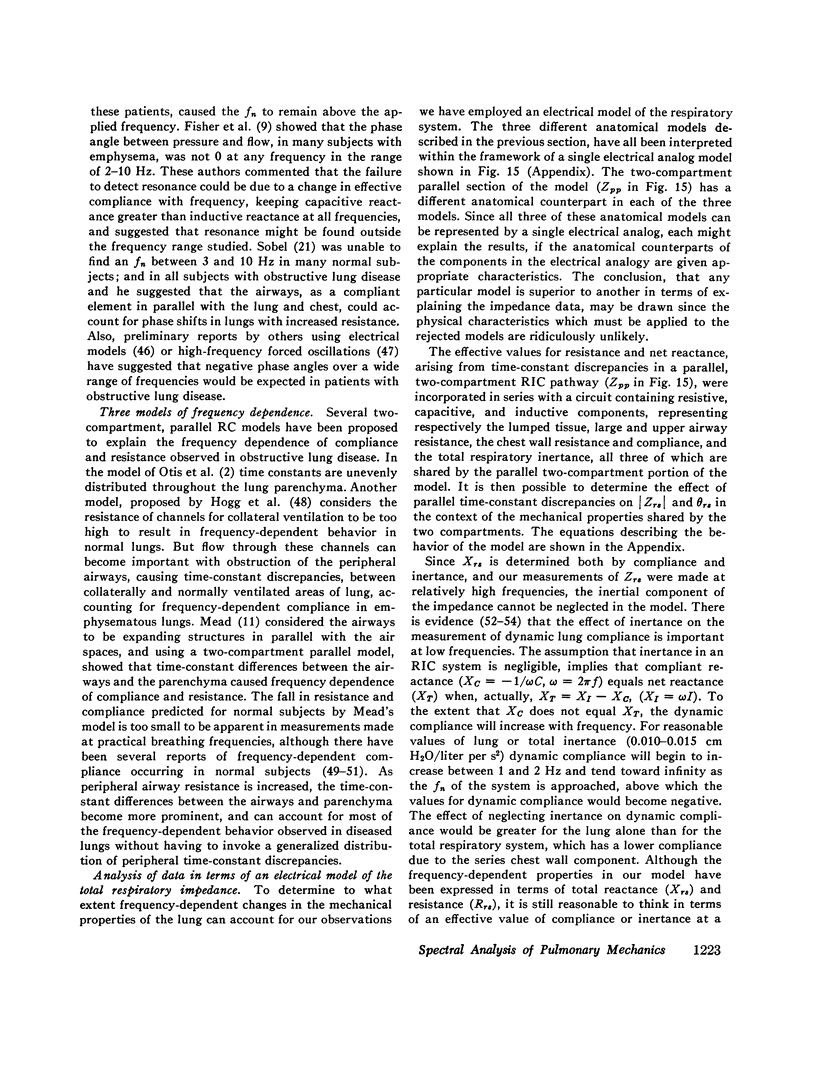

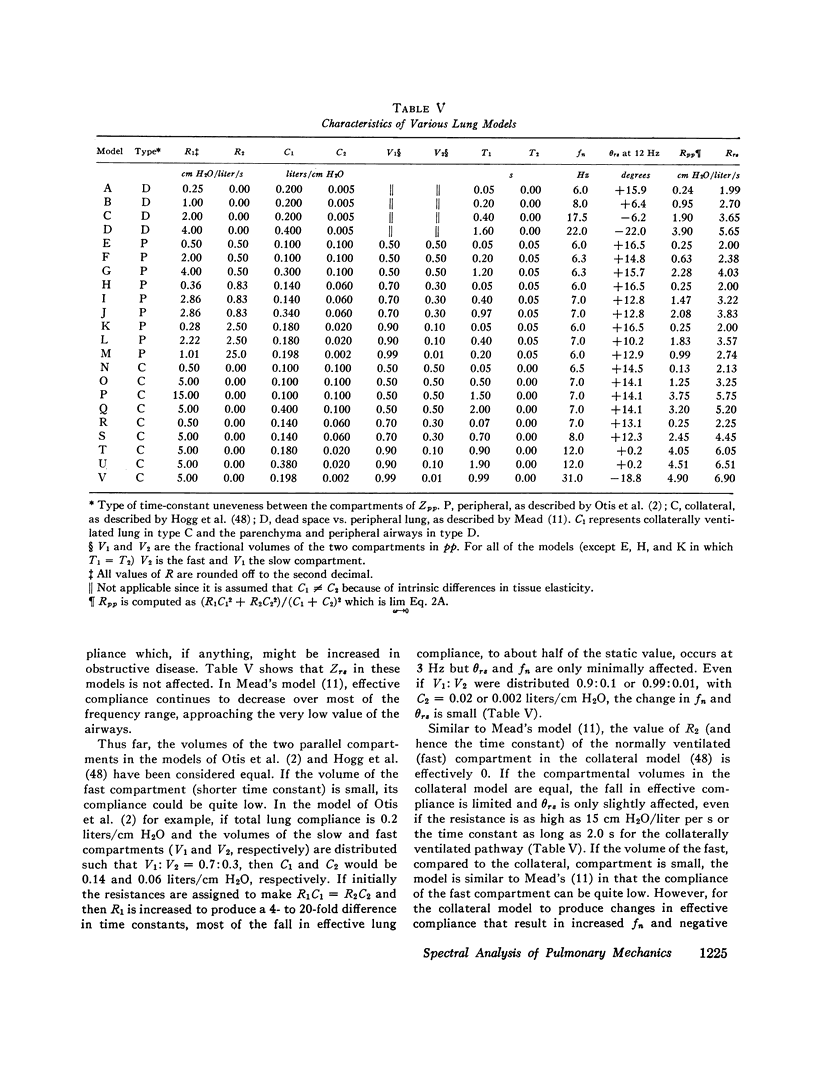
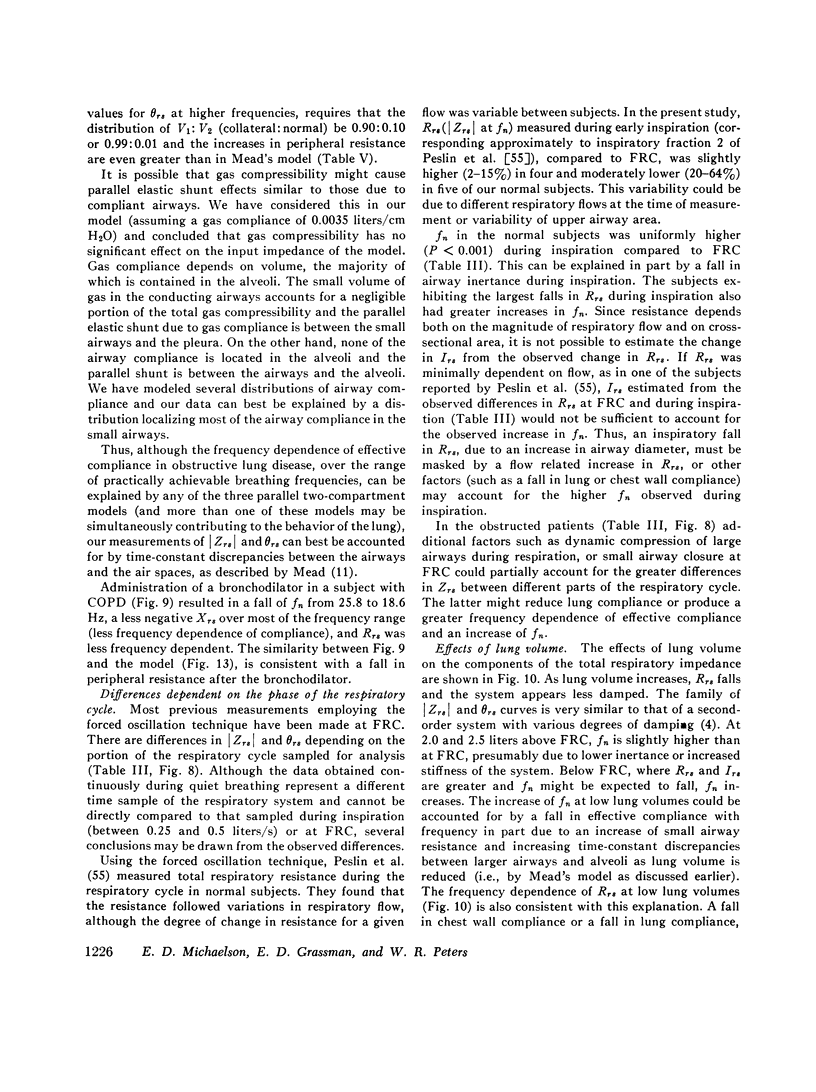
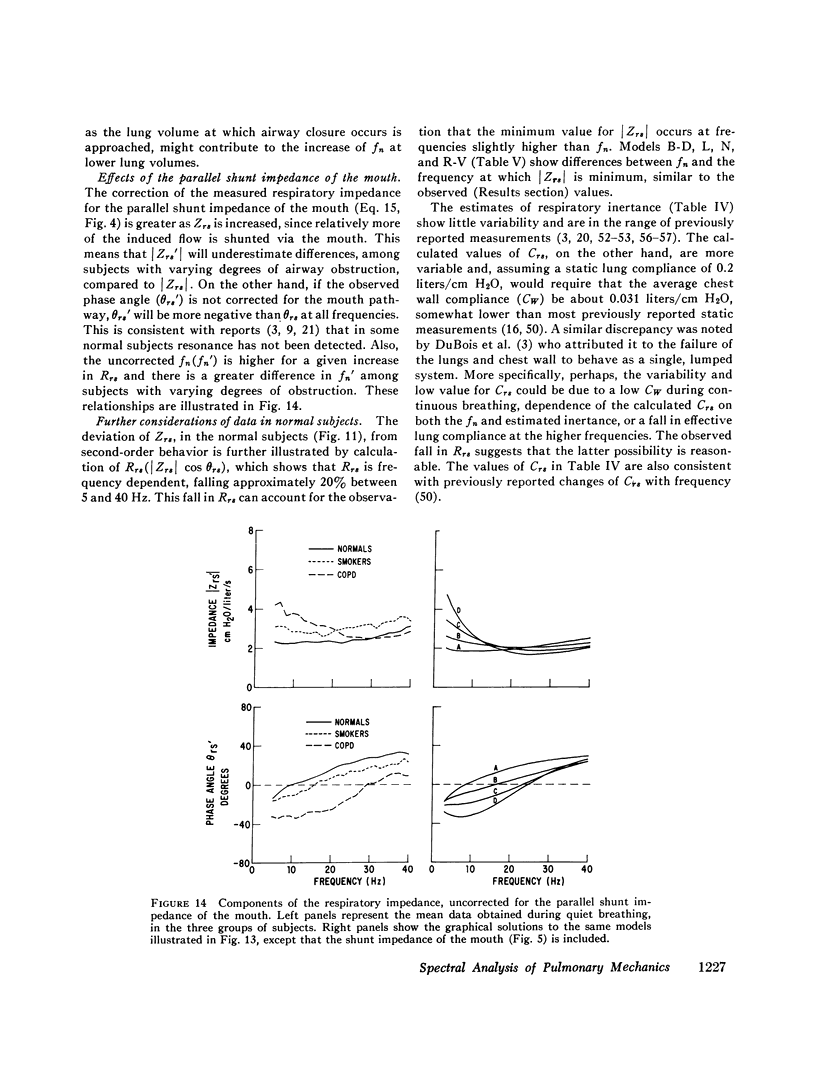
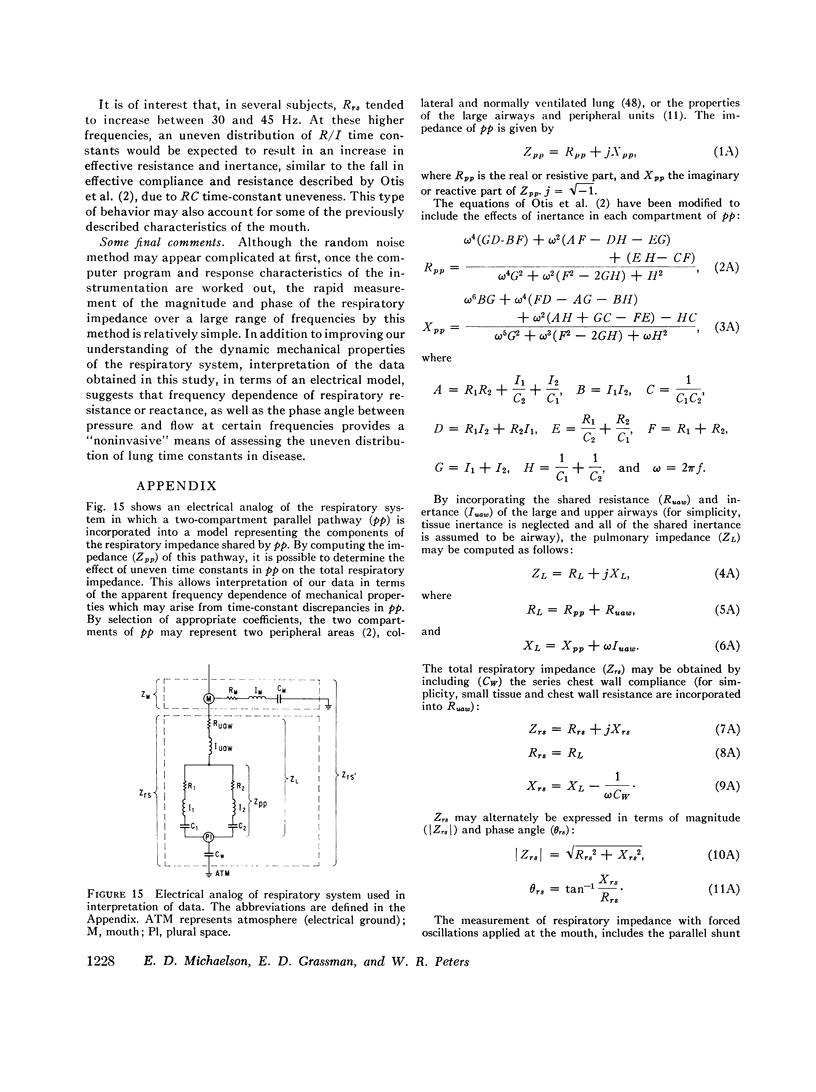
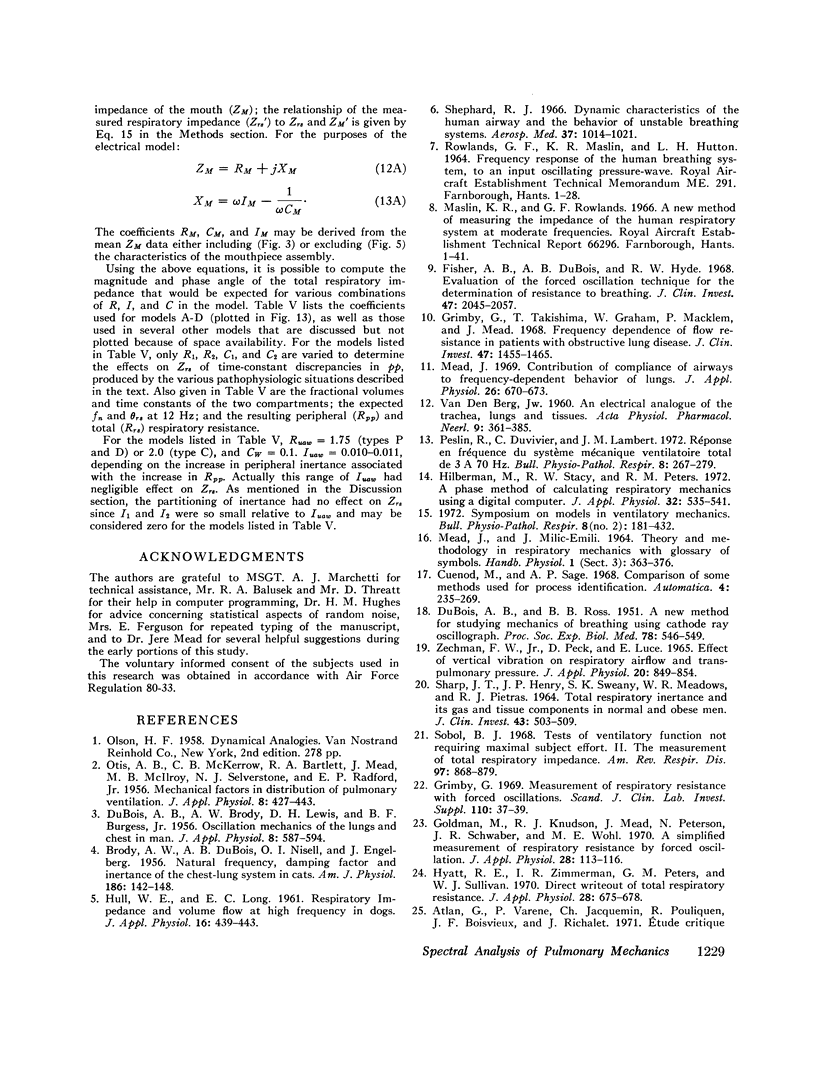
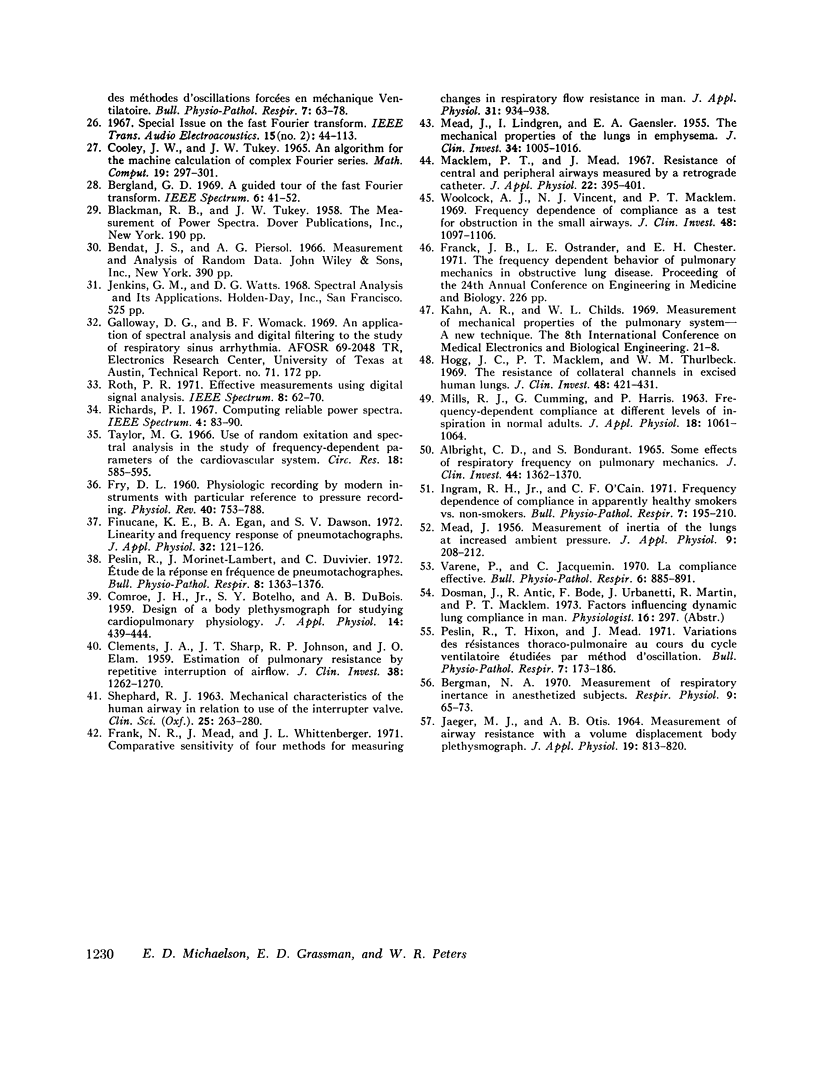
Selected References
These references are in PubMed. This may not be the complete list of references from this article.
- ALBRIGHT C. D., BONDURANT S. SOME EFFECTS OF RESPIRATORY FREQUENCY ON PULMONARY MECHANICS. J Clin Invest. 1965 Aug;44:1362–1370. doi: 10.1172/JCI105241. [DOI] [PMC free article] [PubMed] [Google Scholar]
- BRODY A. W., DUBOIS A. B., ENGELBERG J., NISELL O. I. Natural frequency, damping factor and inertance of the chest-lung system in cats. Am J Physiol. 1956 Jul;186(1):142–148. doi: 10.1152/ajplegacy.1956.186.1.142. [DOI] [PubMed] [Google Scholar]
- Bergman N. A. Measurement of respiratory inertance in anesthetized subjects. Respir Physiol. 1970 Apr;9(1):65–73. doi: 10.1016/0034-5687(70)90007-1. [DOI] [PubMed] [Google Scholar]
- CLEMENTS J. A., SHARP J. T., JOHNSON R. P., ELAM J. O. Estimation of pulmonary resistance by repetitive interruption of airflow. J Clin Invest. 1959 Jul;38(7):1262–1270. doi: 10.1172/JCI103901. [DOI] [PMC free article] [PubMed] [Google Scholar]
- COMROE J. H., Jr, BOTELHO S. Y., DUBOIS A. B. Design of a body plethysmograph for studying cardiopulmonary physiology. J Appl Physiol. 1959 May;14(3):439–444. doi: 10.1152/jappl.1959.14.3.439. [DOI] [PubMed] [Google Scholar]
- DUBOIS A. B., BRODY A. W., LEWIS D. H., BURGESS B. F., Jr Oscillation mechanics of lungs and chest in man. J Appl Physiol. 1956 May;8(6):587–594. doi: 10.1152/jappl.1956.8.6.587. [DOI] [PubMed] [Google Scholar]
- DUBOIS A. B., ROSS B. B. A new method for studying mechanics of breathing using cathode ray oscillograph. Proc Soc Exp Biol Med. 1951 Nov;78(2):546–549. doi: 10.3181/00379727-78-19135. [DOI] [PubMed] [Google Scholar]
- FRY D. L. Physiologic recording by modern instruments with particular reference to pressure recording. Physiol Rev. 1960 Oct;40:753–788. doi: 10.1152/physrev.1960.40.4.753. [DOI] [PubMed] [Google Scholar]
- Finucane K. E., Egan B. A., Dawson S. V. Linearity and frequency response of pneumotachographs. J Appl Physiol. 1972 Jan;32(1):121–126. doi: 10.1152/jappl.1972.32.1.121. [DOI] [PubMed] [Google Scholar]
- Fisher A. B., DuBois A. B., Hyde R. W. Evaluation of the forced oscillation technique for the determination of resistance to breathing. J Clin Invest. 1968 Sep;47(9):2045–2057. doi: 10.1172/JCI105890. [DOI] [PMC free article] [PubMed] [Google Scholar]
- Frank N. R., Mead J., Whittenberger J. L. Comparative sensitivity of four methods for measuring changes in respiratory flow resistance in man. J Appl Physiol. 1971 Dec;31(6):934–938. doi: 10.1152/jappl.1971.31.6.934. [DOI] [PubMed] [Google Scholar]
- Goldman M., Knudson R. J., Mead J., Peterson N., Schwaber J. R., Wohl M. E. A simplified measurement of respiratory resistance by forced oscillation. J Appl Physiol. 1970 Jan;28(1):113–116. doi: 10.1152/jappl.1970.28.1.113. [DOI] [PubMed] [Google Scholar]
- Grimby G., Takishima T., Graham W., Macklem P., Mead J. Frequency dependence of flow resistance in patients with obstructive lung disease. J Clin Invest. 1968 Jun;47(6):1455–1465. doi: 10.1172/JCI105837. [DOI] [PMC free article] [PubMed] [Google Scholar]
- HULL W. E., LONG E. C. Respiratory impedance and volume flow at high frequency in dogs. J Appl Physiol. 1961 May;16:439–443. doi: 10.1152/jappl.1961.16.3.439. [DOI] [PubMed] [Google Scholar]
- Hilberman M., Stacy R. W., Peters R. M. A phase method of calculating respiratory mechanics using a digital computer. J Appl Physiol. 1972 Apr;32(4):535–541. doi: 10.1152/jappl.1972.32.4.535. [DOI] [PubMed] [Google Scholar]
- Hogg J. C., Macklem P. T., Thurlbeck W. M. The resistance of collateral channels in excised human lungs. J Clin Invest. 1969 Mar;48(3):421–431. doi: 10.1172/JCI105999. [DOI] [PMC free article] [PubMed] [Google Scholar]
- Hyatt R. E., Zimmerman I. R., Peters G. M., Sullivan W. J. Direct writeout of total respiratory resistance. J Appl Physiol. 1970 May;28(5):675–678. doi: 10.1152/jappl.1970.28.5.675. [DOI] [PubMed] [Google Scholar]
- Ingram R. H., Jr, O'Cain C. F. Frequency dependence of compliance in apparently healthy smokers versus non-smokers. Bull Physiopathol Respir (Nancy) 1971 Jan-Feb;7(1):195–212. [PubMed] [Google Scholar]
- JAEGER M. J., OTIS A. B. MEASUREMENT OF AIRWAY RESISTANCE WITH A VOLUME DISPLACEMENT BODY PLETHYSMOGRAPH. J Appl Physiol. 1964 Jul;19:813–820. doi: 10.1152/jappl.1964.19.4.813. [DOI] [PubMed] [Google Scholar]
- MEAD J., LINDGREN I., GAENSLER E. A. The mechanical properties of the lungs in emphysema. J Clin Invest. 1955 Jul;34(7 Pt 1):1005–1016. doi: 10.1172/JCI103150. [DOI] [PMC free article] [PubMed] [Google Scholar]
- MEAD J. Measurement of inertia of the lungs at increased ambient pressure. J Appl Physiol. 1956 Sep;9(2):208–212. doi: 10.1152/jappl.1956.9.2.208. [DOI] [PubMed] [Google Scholar]
- MILLS R. J., CUMMING G., HARRIS P. FREQUENCY-DEPENDENT COMPLIANCE AT DIFFERENT LEVELS OF INSPIRATION IN NORMAL ADULTS. J Appl Physiol. 1963 Nov;18:1061–1064. doi: 10.1152/jappl.1963.18.6.1061. [DOI] [PubMed] [Google Scholar]
- Macklem P. T., Mead J. Resistance of central and peripheral airways measured by a retrograde catheter. J Appl Physiol. 1967 Mar;22(3):395–401. doi: 10.1152/jappl.1967.22.3.395. [DOI] [PubMed] [Google Scholar]
- Mead J. Contribution of compliance of airways to frequency-dependent behavior of lungs. J Appl Physiol. 1969 May;26(5):670–673. doi: 10.1152/jappl.1969.26.5.670. [DOI] [PubMed] [Google Scholar]
- OTIS A. B., MCKERROW C. B., BARTLETT R. A., MEAD J., MCILROY M. B., SELVER-STONE N. J., RADFORD E. P., Jr Mechanical factors in distribution of pulmonary ventilation. J Appl Physiol. 1956 Jan;8(4):427–443. doi: 10.1152/jappl.1956.8.4.427. [DOI] [PubMed] [Google Scholar]
- Obol B. J. Tests of ventilatory function not requiring maximal subject effort. II. The measurement of total respiratory impedance. Am Rev Respir Dis. 1968 May;97(5):868–879. doi: 10.1164/arrd.1968.97.5.868. [DOI] [PubMed] [Google Scholar]
- Peslin R., Duvivier C., Lambert J. M. Réponse en fréquence du système mécanique ventilatoire total de 3 a 70 H. Bull Physiopathol Respir (Nancy) 1972 Mar-Apr;8(2):267–279. [PubMed] [Google Scholar]
- Peslin R., Hixon T., Mead J. Variations des résistances thoraco-pulmonaires au cours du cycle ventilatoire étudiées par méthode d'oscillation. Bull Physiopathol Respir (Nancy) 1971 Jan-Feb;7(1):173–188. [PubMed] [Google Scholar]
- Peslin R., Morinet-Lambert J., Duvivier C. Etude de la réponse en fréquence de pneumotachographes. Bull Physiopathol Respir (Nancy) 1972 Nov-Dec;8(6):1363–1376. [PubMed] [Google Scholar]
- SHARP J. T., HENRY J. P., SWEANY S. K., MEADOWS W. R., PIETRAS R. J. TOTAL RESPIRATORY INERTANCE AND ITS GAS AND TISSUE COMPONENTS IN NORMAL AND OBESE MEN. J Clin Invest. 1964 Mar;43:503–509. doi: 10.1172/JCI104936. [DOI] [PMC free article] [PubMed] [Google Scholar]
- SHEPHARD R. J. MECHANICAL CHARACTERISTICS OF THE HUMAN AIRWAY IN RELATION TO USE OF THE INTERRUPTER VALVE. Clin Sci. 1963 Oct;25:263–280. [PubMed] [Google Scholar]
- Shephard R. J. Dynamic characteristics of the human airway and the behavior of unstable breathing systems. Aerosp Med. 1966 Oct;37(10):1014–1021. [PubMed] [Google Scholar]
- Taylor M. G. Use of random excitation and spectral analysis in the study of frequency-dependent parameters of the cardiovascular system. Circ Res. 1966 May;18(5):585–595. doi: 10.1161/01.res.18.5.585. [DOI] [PubMed] [Google Scholar]
- Varène P., Jacquemin C. La compliance effective. Bull Physiopathol Respir (Nancy) 1970 Oct-Dec;6(4):885–891. [PubMed] [Google Scholar]
- Woolcock A. J., Vincent N. J., Macklem P. T. Frequency dependence of compliance as a test for obstruction in the small airways. J Clin Invest. 1969 Jun;48(6):1097–1106. doi: 10.1172/JCI106066. [DOI] [PMC free article] [PubMed] [Google Scholar]
- Zechman F. W., Jr, Peck D., Luce E. Effect of vertical vibration on respiratory airflow and transpulmonary pressure. J Appl Physiol. 1965 Sep;20(5):849–854. doi: 10.1152/jappl.1965.20.5.849. [DOI] [PubMed] [Google Scholar]


